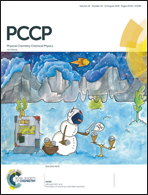Fluorescence anisotropy in indole under two-photon excitation in the spectral range 385–510 nm
Abstract
This paper presents the detailed study of two-photon excited fluorescence in indole dissolved in propylene glycol produced by two-photon absorption from the molecular ground state to several high lying excited states. The experimental method involved excitation with linearly and circularly polarized femtosecond pulses and time-resolved detection of the polarized fluorescence decay. The fluorescence intensity, anisotropy, excited state lifetime, and rotation diffusion time as function of the excitation light wavelength in the spectral range 385–510 nm were determined in experiment. The theoretical fit of the experimental results obtained demonstrated the contributions of six highly excited molecular states of different symmetry to the two-photon absorption intensity and fluorescence anisotropy. An intense two-photon absorption peak was observed experimentally in the spectral range 385–480 nm and explained as contributions from four high lying electronic excited states. The temporal dependence of fluorescence intensity in indole was satisfactory characterized by a single excited state lifetime τf and a single rotational diffusion time τrot. As shown, the excited state lifetime τf depends on the excitation light wavelength, which was explained by taking into account nonradiative relaxation transitions in the molecular vibronic excited states. The rotation diffusion time τrot was found to be equal to τrot = 0.9 ± 0.5 ns and practically independent of the excitation wavelength. The determined molecular anisotropy changed substantially in the spectral area 385–480 nm taking positive and negative values, and the anisotropies referring to linearly and circularly polarized excitation light changed almost in opposite phases with each other. The experimental results obtained were interpreted using ab initio molecular structure computations and a model based on the Frank–Condon approximation and taking into account vibronic absorption bands.



 Please wait while we load your content...
Please wait while we load your content...